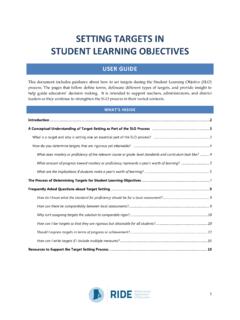Transcription of An evidence-based approach to physical activity
1 Everybody active, every dayOctober 2014 Protecting and improving the nation s healthAn evidence-based approach to physical activityEverybody active, every day2 About Public Health EnglandPublic Health England exists to protect and improve the nation s health and wellbeing, and reduce health inequalities. It does this through advocacy, partnerships, world-class science, knowledge and intelligence, and the delivery of specialist public health services. PHE is an operationally autonomous executive agency of the Department of Health EnglandWellington House 133-155 Waterloo RoadLondon SE1 8 UGTel: 020 7654 Twitter: @PHEukFacebook: Prepared by: Dr Justin Varney, Dr Mike Brannan, Gaynor AaltonenSupported by: Dr Nick Cavill, Stuart King, Luis GuerraDeveloped with over 1,000 health professionals, local authorities, research specialists, educationalists, charities and fitness experts at national and local levels through a process of discussion and engagement.
2 Crown copyright 2014 You may re-use this information (excluding logos) free of charge in any format or medium, under the terms of the Open Government Licence To view this licence, visit OGL or email Where we have identified any third party copyright information you will need to obtain permission from the copyright holders concerned. Any enquiries regarding this publication should be sent to Published October 2014 PHE publications gateway number: 2014432 Everybody active, every day3 ContentsAbout Public Health England 21. Introduction 42. Inactivity: the toll it takes on our health 63. Inequalities: closing the gap 94. Responding to the challenge 105. The four domains for action 12 Active society: creating a social movement 13 Moving professionals: activating networks of expertise 14 Active environments: creating the right spaces 16 Moving at scale: interventions that make us active 186.
3 Measuring impact 197. Making it happen 208. PHE actions to support implementation 219. Chief medical officer s guidelines 22 References 24 Everybody active, every day4 IntroductionA problem that demands a long-term solutionAround one in two women and a third of men in England are damaging their health through a lack of physical This is unsustainable and costing the UK an estimated a ,3 If current trends continue, the increasing costs of health and social care will destabilise public services and take a toll on quality of life for individuals and communities. over one in four women and one in five men do less than 30 minutes of physical activity a week, so are classified as inactive 1 physical inactivity is the fourth largest cause of disease and disability in the UK4 Public Health England (PHE) wants to drive a step change in the public s health.
4 We recently identified seven priorities for the next ten years to tackle the behaviour that increases the risk of poor mental and physical Tackling physical inactivity is critical to delivering many of those priorities (eg, dementia, obesity and giving every child the best start in life). We know from other high-income countries like Finland,6 the Netherlands and Germany,7 that this situation can be changed. The solution is clear: everybody needs to become more active, every wealth of evidence shows that an active life is essential for physical and mental health and wellbeing. A number of diseases are currently on the increase and affecting people at an earlier age. They include cancer and diabetes, and conditions like obesity, hypertension and depression.
5 Regular physical activity can guard us against these. We want to enable people to take control of their current and future health, and to boost parents understanding of how active play and physical literacy is essential for children. Being active at every age increases quality of life and everyone s chances of remaining healthy and independent. The benefits don t stop there. There are many other social, individual and emotional reasons to promote more physical activity . Being active plays a key role in brain development in early childhood8,9 and is also good for longer-term educational Increased energy levels boost workplace productivity and reduce sickness absence. An active population can even reduce levels of crime and antisocial The experience of other countries tells us that getting the whole nation active every day will only happen if we involve all sectors.
6 To make real and lasting change we need to take a long-term, evidence-based approach , building upon what we know works. We need to embed physical activity into the fabric of daily life, making it an easy, cost-effective and normal choice in every community in activity : body movement that expends energy and raises the heart rateInactivity: less than 30 minutes physical activity a weekSedentary: time spent in low-energy postures, eg, sitting or lyingEveryday activity includes cycling, walking, heavy housework, active or manual workActive recreation includes dance, yoga, active play, recreational walking or cyclingSport includes swimming, rowing, fitness training, climbing, parkour, tennis, organised sportsEverybody active.
7 Every day564% of trips are made by car22% are made on foot2% are made by bike19% of men and 26% of women are 'physically inactive'33% of men are not active enough for good health21% of boys and 16% of girls aged 5-15 achieve recommended levels of physical activity47% of boys and 49% of girls in the lowest economic group are 'inactive' compared to 26% and 35% in the highestWalking trips decreased by 30% between 1995 and 201345% of women are not active enough for good health23% of girls aged 5-7 meet the recommended levels of daily physical activity , by ages 13-15 only 8% do 18% of disabled adults regularly take part in sport compared to 39% of non-disabled adultsThe extent of the problemData sources: Health Survey for England 2012 (HSE); Active People Survey 8, April 2013-April 2014 (APS); National Travel Survey 2013 (NTS) We want to engage with professionals, providers and commissioners in health, social care, transportation, planning, education, sport and leisure, the voluntary, community and cultural sectors as well as public and private employers to make the case for more much more physical activity , every active, every day6 InactivityThe toll it takes on our healthPhysical inactivity directly contributes to one in six deaths in the UK:12 the same number as ,14 Around a quarter of us are still classified as inactive, failing to achieve a minimum of 30 minutes of activity a week.
8 In some communities only one in ten adults are active enough to stay healthy. While measurement differences limit direct comparisons, the problem is worse in the UK than many other countries (see graph below). There are several reasons for this. Social, cultural and economic trends have removed physical activity from daily life. Fewer of us have manual Technology dominates at home and work, the two places where we spend most of our time. It encourages us to sit for long periods watching TV, at the computer, playing games or using mobile phones and tablets. Over-reliance on cars and other motorised transport is also a factor. Many features of cities and towns and even some parks work against physical activity .
9 The design of schools, public buildings and urban spaces prioritise convenience and speed ahead of walking or cycling. People sit all day in offices where it is often easier to find the lift than the stairs. Concerns about vandalism and maintenance have left public spaces without the benches and toilets that allow older or disabled people to venture out. Cars and other vehicles dominate, not the needs of government s aim, restated in the report Moving more, living more as a Olympic and Paralympic legacy commitment, is to increase the number of adults taking at least 150 minutes of physical activity a week and to reduce the number taking less than 30 minutes per week, year on ye a Although there has been progress, it remains too 28%France comparison of physical inactivity (at ages 15 and over)15 Around a quarter of us are still classified as inactive, failing to achieve a minimum of 30 minutes of activity a week.
10 In some communities only one in ten adults are active enough to stay healthy Data source: from 122 World Health Organization member states and a specific criteria for inactivityEverybody active, every day7 With time and commitment in short supply, being active every day is as always about weaving incidental activity into our daily lives: taking the opportunity for short trips on foot, by bicycle or on public transport, as well as doing whatever exercise, dance, leisure or sport we enjoy. A snapshot1. The link between physical inactivity and obesity is well established. With more than half of adults and almost a quarter of children overweight or obese,18 ,19, 2 0 everyone would benefit from being more active every day.















